 |
 |
Our enthusiastic and extremely knowledgeable perennials team is here to answer your questions and help you choose the best perennials for your situation. There’s always something in bloom for sun, shade, butterflies, birds or deer resistance as well as a variety of bulbs for your space.
Stroll through our time-tested favorites and introduce yourself to the newest varieties. We garden with perennials too; we love them and it shows!
|
58 found, showing page 2 of 4
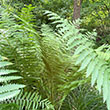
Leaves are light green, turning yellow then bronze in fall. Cinnamon colored fiddleheads are food for ruffed grouse and hummingbirds tend to nest. Native. USDA 3-9.
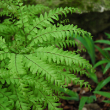
Height: 18 inches
Spread: 24 inches
Sunlight: partial shade, full shade
Hardiness Zone: 1b
Description:
A wonderful low maintenance selection perfect for adding delicate texture to gardens and patio containers; arching fronds of light green turn beautiful golden yellow in the fall; prefers shaded areas with rich and moist well drained soil
Ornamental Features:
Northern Maidenhair Fern is primarily valued in the garden for its cascading habit of growth. Its crinkled ferny compound leaves are light green in color. As an added bonus, the foliage turns a gorgeous gold in the fall. The black stems are very colorful and add to the overall interest of the plant.
Landscape Attributes:
Northern Maidenhair Fern is an herbaceous fern with a shapely form and gracefully arching fronds. It brings an extremely fine and delicate texture to the garden composition and should be used to full effect.
This is a relatively low maintenance plant, and usually looks its best without pruning, although it will tolerate pruning. Deer don't particularly care for this plant and will usually leave it alone in favor of tastier treats. It has no significant negative characteristics.
Northern Maidenhair Fern is recommended for the following landscape applications:
- Mass Planting
- Rock/Alpine Gardens
- General Garden Use
- Groundcover
- Naturalizing And Woodland Gardens
Planting & Growing:
Northern Maidenhair Fern will grow to be about 18 inches tall at maturity, with a spread of 24 inches. Its foliage tends to remain dense right to the ground, not requiring facer plants in front. It grows at a slow rate, and under ideal conditions can be expected to live for approximately 15 years. As an herbaceous perennial, this plant will usually die back to the crown each winter, and will regrow from the base each spring. Be careful not to disturb the crown in late winter when it may not be readily seen!
This plant does best in partial shade to shade. It prefers to grow in moist to wet soil, and will even tolerate some standing water. It is not particular as to soil pH, but grows best in rich soils. It is highly tolerant of urban pollution and will even thrive in inner city environments, and will benefit from being planted in a relatively sheltered location. Consider applying a thick mulch around the root zone over the growing season to conserve soil moisture. This species is native to parts of North America, and parts of it are known to be toxic to humans and animals, so care should be exercised in planting it around children and pets. It can be propagated by division.

2-3 foot leathery fronds stay green all winter, giving it its name. Silvery fiddleheads emerge in early spring. USDA 3-9

2?3 foot leathery fronds stay green all winter, giving it its name. Silvery fiddleheads emerge in early spring. USDA 3-9
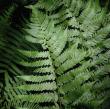
Height: 4 feet
Spread: 3 feet
Sunlight: partial shade, full shade
Hardiness Zone: 4b
Description:
This tall fern is a great vertical accent; has graceful, arching fronds; keep evenly moist, provides habitat and shelter for birds and bees.
Ornamental Features:
Dixie Wood Fern is primarily valued in the landscape or garden for its cascading habit of growth. Its tiny ferny compound leaves remain green in color throughout the year.
Landscape Attributes:
Dixie Wood Fern is an herbaceous evergreen fern with a shapely form and gracefully arching fronds. It brings an extremely fine and delicate texture to the garden composition and should be used to full effect.
This is a relatively low maintenance plant, and should be cut back in late fall in preparation for winter. Deer don't particularly care for this plant and will usually leave it alone in favor of tastier treats. It has no significant negative characteristics.
Dixie Wood Fern is recommended for the following landscape applications:
- Mass Planting
- General Garden Use
- Naturalizing And Woodland Gardens
Planting & Growing:
Dixie Wood Fern will grow to be about 4 feet tall at maturity, with a spread of 3 feet. Its foliage tends to remain dense right to the ground, not requiring facer plants in front. It grows at a medium rate, and under ideal conditions can be expected to live for approximately 15 years. As an evegreen perennial, this plant will typically keep its form and foliage year-round. As this plant tends to go dormant in summer, it is best interplanted with late-season bloomers to hide the dying foliage.
This plant does best in partial shade to shade. It prefers to grow in average to moist conditions, and shouldn't be allowed to dry out. It is particular about its soil conditions, with a strong preference for rich, acidic soils. It is somewhat tolerant of urban pollution, and will benefit from being planted in a relatively sheltered location. Consider applying a thick mulch around the root zone over the growing season to conserve soil moisture. This particular variety is an interspecific hybrid, and parts of it are known to be toxic to humans and animals, so care should be exercised in planting it around children and pets. It can be propagated by division; however, as a cultivated variety, be aware that it may be subject to certain restrictions or prohibitions on propagation.

A vigorous, deciduous vase-shaped fern with shamrock green arching fronds. USDA 3-8
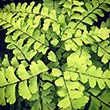
Finely textured frilly fronds. Wiry stems. Native. Clumping. USDA 3-8
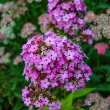
Plant Height: 3 feet
Flower Height: 4 feet
Spacing: 30 inches
Sunlight: full sun, partial shade
Hardiness Zone: 3a
Other Names: Summer Phlox
Description:
Beautiful, fragrant, lavender pink flowers with white flares near the center, that bloom prolifically in mid-summer; multi-branched, upright habit; excellent for perennial borders; good mildew resistance
Ornamental Features:
Jeana Garden Phlox features bold fragrant conical lavender star-shaped flowers with pink overtones and a white flare at the ends of the stems from mid summer to early fall. The flowers are excellent for cutting. Its narrow leaves remain emerald green in color throughout the season.
Landscape Attributes:
Jeana Garden Phlox is a dense herbaceous perennial with an upright spreading habit of growth. Its medium texture blends into the garden, but can always be balanced by a couple of finer or coarser plants for an effective composition.
This plant will require occasional maintenance and upkeep, and should be cut back in late fall in preparation for winter. It is a good choice for attracting butterflies and hummingbirds to your yard. Gardeners should be aware of the following characteristic(s) that may warrant special consideration:
- Disease
Jeana Garden Phlox is recommended for the following landscape applications:
- Mass Planting
- Border Edging
- General Garden Use
- Container Planting
Planting & Growing:
Jeana Garden Phlox will grow to be about 3 feet tall at maturity extending to 4 feet tall with the flowers, with a spread of 3 feet. When grown in masses or used as a bedding plant, individual plants should be spaced approximately 30 inches apart. It grows at a medium rate, and under ideal conditions can be expected to live for approximately 10 years. As an herbaceous perennial, this plant will usually die back to the crown each winter, and will regrow from the base each spring. Be careful not to disturb the crown in late winter when it may not be readily seen!
This plant does best in full sun to partial shade. It does best in average to evenly moist conditions, but will not tolerate standing water. It is not particular as to soil type or pH. It is highly tolerant of urban pollution and will even thrive in inner city environments. This is a selection of a native North American species. It can be propagated by division; however, as a cultivated variety, be aware that it may be subject to certain restrictions or prohibitions on propagation.
Jeana Garden Phlox is a fine choice for the garden, but it is also a good selection for planting in outdoor pots and containers. With its upright habit of growth, it is best suited for use as a 'thriller' in the 'spiller-thriller-filler' container combination; plant it near the center of the pot, surrounded by smaller plants and those that spill over the edges. It is even sizeable enough that it can be grown alone in a suitable container. Note that when growing plants in outdoor containers and baskets, they may require more frequent waterings than they would in the yard or garden.
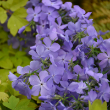
Height: 12 inches
Spacing: 10 inches
Sunlight: partial shade, full shade
Hardiness Zone: 4a
Other Names: Woodland Phlox
Description:
A choice variety with overlapping petals of passionate blue fragrant flowers that bloom early and persist; a wonderful plant for borders and edging; not prone to mildew, and grows best in slightly dry conditions
Ornamental Features:
Blue Moon Phlox is smothered in stunning lightly-scented blue star-shaped flowers at the ends of the stems from mid to late spring. Its narrow leaves remain green in color throughout the season.
Landscape Attributes:
Blue Moon Phlox is a dense herbaceous perennial with a mounded form. Its relatively fine texture sets it apart from other garden plants with less refined foliage.
This plant will require occasional maintenance and upkeep, and should be cut back in late fall in preparation for winter. Deer don't particularly care for this plant and will usually leave it alone in favor of tastier treats. Gardeners should be aware of the following characteristic(s) that may warrant special consideration:
- Spreading
Blue Moon Phlox is recommended for the following landscape applications:
- Mass Planting
- Border Edging
- General Garden Use
- Groundcover
Planting & Growing:
Blue Moon Phlox will grow to be about 12 inches tall at maturity, with a spread of 12 inches. When grown in masses or used as a bedding plant, individual plants should be spaced approximately 10 inches apart. Its foliage tends to remain dense right to the ground, not requiring facer plants in front. It grows at a fast rate, and under ideal conditions can be expected to live for approximately 10 years. As an herbaceous perennial, this plant will usually die back to the crown each winter, and will regrow from the base each spring. Be careful not to disturb the crown in late winter when it may not be readily seen!
This plant does best in partial shade to shade. It does best in average to evenly moist conditions, but will not tolerate standing water. It is not particular as to soil type or pH. It is quite intolerant of urban pollution, therefore inner city or urban streetside plantings are best avoided, and will benefit from being planted in a relatively sheltered location. Consider applying a thick mulch around the root zone over the growing season to conserve soil moisture. This is a selection of a native North American species. It can be propagated by division; however, as a cultivated variety, be aware that it may be subject to certain restrictions or prohibitions on propagation.
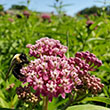
This monarch host plant produces pink blooms summer through fall. Requires moist soils. Self-seeder. Native. USDA 3-6
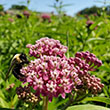
Plant Height: 3 feet
Flower Height: 4 feet
Spread: 32 inches
Sunlight: full sun partial shade
Hardiness Zone: 2a
Other Names: Butterfly Weed
Description:
A wonderful selection for attracting butterflies to garden beds and rain gardens; this upright selection features clusters of rosy-pink, fragrant flowers and green narrow foliage; a compact variety that is easy to grow, needing little to no maintenance
Ornamental Features:
Swamp Milkweed has fuchsia flat-top flowers with rose overtones at the ends of the stems from mid summer to early fall. The flowers are excellent for cutting. Its narrow leaves remain grayish green in color throughout the season.
Landscape Attributes:
Swamp Milkweed is an herbaceous perennial with an upright spreading habit of growth. Its medium texture blends into the garden, but can always be balanced by a couple of finer or coarser plants for an effective composition.
This is a relatively low maintenance plant, and is best cleaned up in early spring before it resumes active growth for the season. It is a good choice for attracting butterflies to your yard, but is not particularly attractive to deer who tend to leave it alone in favor of tastier treats. It has no significant negative characteristics.
Swamp Milkweed is recommended for the following landscape applications:
- Mass Planting
- General Garden Use
- Naturalizing And Woodland Gardens
- Bog Gardens
Planting & Growing:
Swamp Milkweed will grow to be about 3 feet tall at maturity extending to 4 feet tall with the flowers, with a spread of 32 inches. It tends to be leggy, with a typical clearance of 1 foot from the ground, and should be underplanted with lower-growing perennials. It grows at a medium rate, and under ideal conditions can be expected to live for approximately 10 years. As an herbaceous perennial, this plant will usually die back to the crown each winter, and will regrow from the base each spring. Be careful not to disturb the crown in late winter when it may not be readily seen!
This plant does best in full sun to partial shade. It is quite adaptable, prefering to grow in average to wet conditions, and will even tolerate some standing water. It is not particular as to soil type or pH. It is quite intolerant of urban pollution, therefore inner city or urban streetside plantings are best avoided. This species is native to parts of North America.
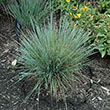
Showy seed heads. Blue-green foliage. Upright. Native. USDA 3-9
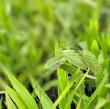
Height: 5 feet
Spread: 30 inches
Sunlight: full sun, partial shade
Hardiness Zone: 4a
Other Names: Uniola latifolia
Description:
This grass is grown for its lovely drooping hop-like seed heads that flutter in the wind; the seed heads mature to a purple-bronze color and make a nice accent when left on through the winter; use for fresh and dried flower arrangements
Ornamental Features:
Northern Sea Oats is primarily grown for its highly ornamental fruit. It produces abundant clusters of purple hop-like fruit from late summer to late fall. It grassy leaves are light green in color. As an added bonus, the foliage turns a gorgeous coppery-bronze in the fall.
Landscape Attributes:
Northern Sea Oats is an herbaceous perennial grass with a shapely form and gracefully arching stems. Its medium texture blends into the garden, but can always be balanced by a couple of finer or coarser plants for an effective composition.
This is a relatively low maintenance plant, and is best cleaned up in early spring before it resumes active growth for the season. It has no significant negative characteristics.
Northern Sea Oats is recommended for the following landscape applications:
- Accent
- Mass Planting
- Border Edging
- General Garden Use
- Naturalizing And Woodland Gardens
- Container Planting
Planting & Growing:
Northern Sea Oats will grow to be about 4 feet tall at maturity, with a spread of 30 inches. Its foliage tends to remain dense right to the ground, not requiring facer plants in front. It grows at a medium rate, and under ideal conditions can be expected to live for approximately 10 years. As an herbaceous perennial, this plant will usually die back to the crown each winter, and will regrow from the base each spring. Be careful not to disturb the crown in late winter when it may not be readily seen!
This plant does best in full sun to partial shade. It is quite adaptable, prefering to grow in average to wet conditions, and will even tolerate some standing water. It is not particular as to soil type or pH. It is somewhat tolerant of urban pollution. This species is native to parts of North America.
Northern Sea Oats is a fine choice for the garden, but it is also a good selection for planting in outdoor pots and containers. Because of its height, it is often used as a 'thriller' in the 'spiller-thriller-filler' container combination; plant it near the center of the pot, surrounded by smaller plants and those that spill over the edges. It is even sizeable enough that it can be grown alone in a suitable container. Note that when growing plants in outdoor containers and baskets, they may require more frequent waterings than they would in the yard or garden.
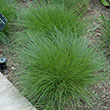
Purple bloom. Upright foliage with blue base. Fall color. Native. USDA 3-9
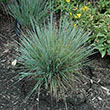
Patent: PP25202
Height: 4 feet
Spread: 20 inches
Sunlight: full sun
Hardiness Zone: 3a
Other Names: Little Bluestem
Description:
An excellent variety for hot, dry areas with consistent green-blue, ribbon-like foliage that takes on hues of violet-purple in fall; silvery white seed heads persist well into winter; an outstanding accent plant
Ornamental Features:
Standing Ovation Bluestem's attractive grassy leaves are dark green in color with showy silvery blue variegation and tinges of purple on a plant with an upright spreading habit of growth. As an added bonus, the foliage turns a gorgeous violet in the fall. It has masses of beautiful spikes of purple flowers rising above the foliage in late summer, which are most effective when planted in groupings.
Landscape Attributes:
Standing Ovation Bluestem is an herbaceous perennial grass with an upright spreading habit of growth. It brings an extremely fine and delicate texture to the garden composition and should be used to full effect.
This is a relatively low maintenance plant, and is best cut back to the ground in late winter before active growth resumes. It has no significant negative characteristics.
Standing Ovation Bluestem is recommended for the following landscape applications:
- Mass Planting
- General Garden Use
- Groundcover
Planting & Growing:
Standing Ovation Bluestem will grow to be about 3 feet tall at maturity, with a spread of 20 inches. It grows at a medium rate, and under ideal conditions can be expected to live for approximately 10 years. As an herbaceous perennial, this plant will usually die back to the crown each winter, and will regrow from the base each spring. Be careful not to disturb the crown in late winter when it may not be readily seen!
This plant should only be grown in full sunlight. It is very adaptable to both dry and moist locations, and should do just fine under typical garden conditions. It is considered to be drought-tolerant, and thus makes an ideal choice for a low-water garden or xeriscape application. It is not particular as to soil type or pH. It is somewhat tolerant of urban pollution. This is a selection of a native North American species. It can be propagated by division; however, as a cultivated variety, be aware that it may be subject to certain restrictions or prohibitions on propagation.
58 found, showing page 2 of 4













